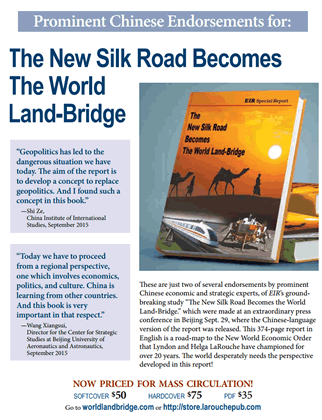President Assad’s ‘Five Seas Vision’
by Ulf Sandmark
March 2016
A PDF version of this article is published in the November 13, 2015 issue of Executive Intelligence Review and is re-published here with permission.
Syrian President Bashar Assad launched his “Five Seas Vision” officially in 2004, a vision aimed at taking advantage of Syria’s geographic position to put it at the center of a regional energy and transportation network. Before the foreign-orchestrated war on Syria began in 2011, President Assad criss-crossed the region with large delegations, visiting neighboring countries and beyond to pursue his plan. Many agreements were made, including with Turkey, Romania, Ukraine, Azerbaijan, Iran, Iraq, and Lebanon.

courtesy of Ulf Sandmark
Co-author Ulf Sandmark (center) and Swedish architect Greger Ahlberg (left) with other members of the delegation of the Swedish association the Syrian Support Committee for Democracy, and the head of the Umayyad Mosque in Damascus (second from left), during their November 2014 visit to Syria. |
These agreements included the following huge pipeline projects: a gas pipeline from Iran; a pipeline into Turkey linking up in with the planned Nabucco gas pipeline from Azerbaijan; and the rebuilding of the oil pipeline from Northern Iraq into Syria. Syria’s official five-year plan, launched in 2004, projected vigorous measures for building the roads, ports, and pipelines inside the country necessary for realizing the “Five Seas Vision.”
President Assad’s vision, however, goes beyond the region. Speaking to The Weekly Middle East Reporter Aug. 1, 2009 Assad explained his idea: “Once the economic space between Syria, Turkey, Iraq and Iran becomes integrated, we would link the Mediterranean, Caspian, Black Sea, and the [Persian] Gulf . . . we aren’t just important in the Middle East. . . Once we link these four seas, we become the unavoidable intersection of the whole world in investment, transport, and more.”
 View the report View ad full size |
 View full size |
With this policy, President Assad was acting in the same spirit that launched a sea change of independent South-South relations in the wake of the 2003 British/U.S.-led invasion of Iraq. The worldwide protests and resistance to that war formed itself into an international revolt against the global world order, leading up to the formation of the BRICS Alliance. As Dania Akkad described it in Syria Times in 2011, the “Five Seas Vision” “should be taken as a symbol that Syria will no longer depend on the Unitee States and its main allies for stability, a message that many other countries—Venezuela, Brazil and Argentina, for example—have also been asserting in recent years.” (See article)
The Jamestown Foundation’s Christina Lin brings up the obvious historic background to the “Five Seas Vision” in her article “The Caspian Sea: China’s Silk Road Strategy Converges with Damascus,” published Aug. 19, 2010:
Such a policy, which now carries Assad’s signature, is not new. It existed during the heyday of the Umayyad Dynasty (661-750), when it was actually six rather than five seas, reaching as far as the Baltic Sea where the Umayyads—the first great Muslim dynasty to rule the Empire of the Caliphate—excelled as merchants, rather than as politicians or military conquerors.
That empire covered more than five million square miles, around one trillion hectares, reaching far and wide with trade routes and political influence felt throughout India, China, North Africa, and Spain. Damascus, the legitimate child and former capital of that empire, sees it as very possible to re-connect the six seas in today’s world. This policy envisions a network of operations all running through Syria for the transfer of oil and gas, goods, manpower, and ideas, connecting the Caucasus in the north with the Arab Gulf in the south, Iran in the east, and Europe in the west. . . . Collectively, if these countries are linked via Syria, they add up to a human cluster of no less than 288 million people—a bloc that cannot be ignored, and perhaps not defeated.
The perspective of the formation of such a bloc is more than enough to explain why the geopoliticians of the West today insist that Assad must go.
